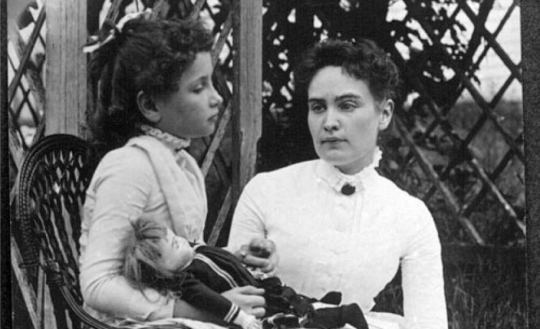Four Stories about Storytelling

(originally posted on Medium)
Or the story about Helen Keller, the Kudzu, Babe Ruth, David Copperfield, & Your Startup.
The Power of Stories
As a child I believed logical arguments were enough to convince anyone of anything. You just needed enough time to explain them in painstaking, rational detail, and others would listen and understand.
As an adult, I know the world operates on story first, and logic second. The truth only matters for good stories, and most people don’t know how to tell good stories.
The difference in story-telling ability is massive; a poorly told story might bore the dinner table, a well-told story starts wars, create nations, and (one day!) colonizes mars. Behold the power of words: you make a bunch of sounds or symbols, and someone else reprioritizes their time & energy… woah.
The story of your company is a major, major piece of what “it” is, throughout its entire life — in fact, it’s the only thing “it” is in the very beginning, and that story, that “it”, is how you recruit employees, convince customers to give you a shot, and secure funding. Investors & smart hires will always do appropriate diligence before investing money & time, but they won’t bother doing that any diligience at all unless they are excited about your story. You can’t hand people a dry plan and expect them to “grok” the genius of your opportunity the same way you do. Generating excitement in others solely rests on you and the power of your story.
So this post is about story telling, and specifically about the 4 types of stories you’ll need to be able to tell well when fundraising for your company- but all of them are useful for recruiting, internal alignment, business development, and beyond. The pen (keyboard? thumb? Siri?) is mightier than the sword, so don’t neglect the narrative.
Let’s take a seat, it’s story time.
Helen Keller & The Hero’s Journey

When Helen Keller was only a year-and-a-half old, illness left her blind & deaf, and her prospects for communication looked grim. Six years later, in 1886, her parents found & called upon Anne Sullivan, an experienced teacher of the blind, to help a 7-year old Helen learn to communicate in terms of names and letters. Teaching Helen was immensely challenging, and when it seemed like she might never learn, Anne spelled “water” on Helen’s hand while running it under cool water. In that moment, language and naming ‘clicked’ for Helen.
18 years later, Helen graduated from Radcliffe (now a part of Harvard) as the first deaf/blind person with a Bachelor of Arts. She became a prolific writer (12 books, while you & I struggle with 1 email or 1 blog post!) She became a lecturer. She was a political activist fighting for those with disabilities, for women’s suffrage, for birth-control, for peace.
Helen Keller was a hero.
In fact, her life follows the “Hero’s Journey” wonderfully, and if you’re not familiar with the concept, you can see the arc here:

At its core, the Hero’s Journey is about venturing from the known into the unknown, and with a bit of help & digging deep, learning something critical to conquer your challenge, and then sharing that revelation with world for broader transformation.
Who better to advocate for the capability of the disabled than Helen Keller, who not only triumphed & demonstrated communication-competency, but mastery of communication in all its forms?
Being told factually that blind/deaf individuals are capable of writing & lecturing isn’t nearly as powerful and moving as the Hero’s Journey of Helen Keller. In the same way, you and your startup are your own “Hero’s Journey” and are much more compelling when framed in that narrative. Investors are looking for the “why you?” “what makes you so special?” “what hard-fought secret have you learned?” — don’t share the insight, tell the story.
Exempli gratia: Slack.
Stuart Butterfield had a vision for a non-violent MMO, and founded Tiny Speck to bring that vision to life. Team assembled, they set to work building tools, and building the game. Years later, they enthusiastically released their baby, “Glitch”, to the world, and though the game earned some following, it wasn’t enough. Tiny Speck decided to sunset Glitch and began winding down its operations. However, in a great moment of insight, Stuart & team realized the chat platform they had developed to support more productive game-development was a product that could help any team be more productive. Thus, Slack was born in the companies darkest hour, and now Slack’s team is bringing a new platform for team productivity to the world.

Interestingly, Stuart’s previous project Flickr was born from a previous failure at making the game. The poor guy just wants to make games and keeps accidentally changing the way the world communicates. A nice account of Stuart’s story is here.
The Kudzu & Disruption
Evolution is a fascinating thing to study. Understanding that species not only evolve against their environment, but how their environment co-evolves simultaneously against them, I find intriguing. Did the humming bird’s beak evolve & lengthen to get at a long-flowered plant’s nectar, or did some plant have the opportunity to evolve in length in order to keep pollinating-inefficient bees out, because the a primordial humming-bird was there to provide a substitute?
When you look at a biological ecosystem, the creatures in it have spent thousands & thousands of years co-evolving against one another in a careful dance. The same metaphor is true for modern, ‘legacy’ businesses — most businesses that exist today have co-evolved against one another in a careful dance of suppliers, distributors, competitors, and partners.
Enter the Kudzu.
Co-evolution in an ecosystem is a beautiful and importantly a relatively stable thing. But what happens when you transplant an organism from one ecosystem into another? Three things:
- Likely, it will be brutally selected against (i.e.: die)
- Occasionally it will find a niche & join the careful co-evolution dance.
- But sometimes… sometimes it DOMINATES the ecosystem and changes the waltz to a salsa.
This is an invasive species. It’s alien to the ecosystem, doesn’t know the dance-steps and doesn’t care, because none of the native-organisms had any chance to evolve meaningful defenses against it. It dances the salsa while flustered waltzers leave the ballroom floor (read: they die).
The Kudzu is a salsa-dancing plant, native to a colder salsa-dancing Chinese ecosystem. And while the Kudzu is naturally fast-growing (up to a foot a day), and can kill existing vegetation by growing right over it & shading it out, this isn’t a problem when the Chinese winter beats it back each year, keeping it in check relative to other plants it salsa-dances with.
Then, also in the 1880s, some clever American entrepreneurs decided to market a “fast growing, shade generating” plant to the overly warm citizens living the waltz-dancing climate of the south-eastern United States.
Flash forward 100 years: now listed as a noxious weed, the Kudzu is found as far north as NYC and Nova Scotia Canada, and covers 7.5 million acres of land.

The Kudzu, and other invasive species, are disruptive technologies — the ecosystem it was introduced into didn’t stand a chance against it, because they never had a chance to co-evolve against it- and so it runs rampant. In contrast to the heroism of Helen Keller, your startup’s story also needs to demonstrate its Kudzu-like invasiveness, how no incumbents are adapted, nor could any adapt fast enough. Are you aggregating & leveraging a competitive data-set none will be able to reproduce? Are you bringing an army of algorithm authors to attack a sleep non-technical industry? Are you able to achieve pricing 10x better than incumbents due to unfair cost advantages? Etc, etc, etc. While stories of ‘disruption’ are numerous, real disruption stories look like invasive species stories.
My favorite recent disruption story is, somewhat predictably, Uber’s story. Uber was born from a simple desire, “why can’t I just use my phone to tap-summon a taxi?” and a brilliant insight: tap-summoning black-cars skirts the laws that prevent non-taxis from picking up people on the street. Since the tap-summon is a “pre-arrangement”, no laws have been broken.
So what happens when a singular silicon valley tech/UX/data-driven/mobile focused company invades a progress-sleepy/frustrating/dirty-money-driven/waving-into-the-air based taxi industry that is horribly fragmented not only nationally but per-city and could never recreate the experience or market liquidity of an aggregated (and far superior) offering from Uber? Well, the un-adapted /un-adaptable industry fights the only way they can (litigating) while the rest of us cheaply & happily zip from place to place, and the tech-Kudzu that is Uber is valued in the tens of billions.
Be the Kudzu.
Babe Ruth & The Called Shot
Babe Ruth is an American baseball player famous for his larger than life personality, and larger than life talent. He played for the New York Yankees between 1920 and 1934. In 1932, when the Yankees made it to the world series, and Babe Ruth stepped up to the plate as batter, he was met with lemon throwing and jeers from hostile fans. With two strikes (three and you’re out) Babe Ruth pointed straight down the field. The pitch was thrown, he swung the bat, and hit a home run exactly in the direction he had pointed, and that moment became famous as the “Babe Ruth called shot”.

The “Called Shot” is the epitome of execution- “this is what I’m going to do, watch me do it”, and the implied “I told you so”. Data can sometimes speak for itself, but when it’s part of a “called shot” story, it’s incredibly powerful. I’m not a sports guy by any stretch of the imagination, but here you & I are 80 years later reading/writing about someone who pointed his finger and swing a bat, that’s how emotionally impactful the called shot is — it burns a memory like little else.
Each financing you raise is to get to the next milestone, so when pitching your startup, some portion of your pitch should include a called shot.
“We are raising this seed to go do X”…. then go do X.
Because then when you go back to the same capital market for your Series A, and say “We are raising this A to do Y” you’ll have a lot of folks leaning in. Even if you didn’t pitch a particular investor for your previous round, if you contextualize your raise around “Seed was designed to do X, we did X, Series A is designed to do Y” you’re showcasing your foresight and execution powerfully.
This data & execution framing technique isn’t limited to financings. Trying to recruit a co-founder or key-employee? Regularly update them on your plan, expectations, and show that you’re a predictable knock-it-out-of-the-park machine.
“Our vision is to be the world’s most consumer-centric company, where customers can come to find anything they want to buy online.” — Jeff Bezos
David Copperfield & Framing the Theory
If I wanted to do something bold, something big, something impossible like making the Statue of Liberty disappear and televising it— what would have to happen for you to believe I did that? Well certainly:
- Not only would the TV cameras show it had disappeared, but
- They would film in long, un-cut arcs free of trickery,
- A credible live crowd would testify live at the truth of the spectacle,
- Search lights would pass right through where the statue used to stand,
- Helicopters circling with cameras would confirm the dissapearce from multiple perspectives,
- and even radar would confirm the loss of a giant metal structure.

David Copperfield proposed, and dramatically executed the disappearance (and re-appareance) of the Statue of Liberty in 1983 to a live audience on Liberty Island, and live audiences around the world. This was more than just a called shot, and far more than sleight of hand, this was story telling of the grandest kind.
If a magician can convince people of the truth of the impossible, what you should be able to do around probability of the plausible?
Ultimately, your startup is a hypothesis you’ll build into a theory. “Because of insights A/B/C, if we build D/E/F, we’ll grow fast in markets J/K/L, and you’ll know we’re on the right path because of metrics that look like X/Y/Z.” You need to clearly frame your core hypothesis, and you need to frame the metrics & indicators that would confirm its deeper truth.
The point isn’t to emulate the friendly deceitfulness of magicians like David Copperfield, but to appreciate how much care they take in guiding the audience to understand the depth of their illusion, how to judge its execution, and how to appreciate the experience. Define your startup’s hypothesis, help others see the best way to appreciate it, explain the metrics by which they should judge your execution, and let them appreciate the results you have to date.
Be authentic, be believable, and take charge of the framing.
Go Forth & Story Tell
Never burden your audience- you should be so lucky to get the attention of someone smart, let alone someone masochistic enough to dig-in on something they don’t find exciting. If they are worth talking to, their attention is already valued at a premium, and they have plenty of options.
Moreover, why should others invest time & money into a poorly told story? If the founder of a startup isn’t their own opportunity’s best story-teller, who could possibly come to understand it better than they? And in the rare case that the listener might appreciate the genius buried beneath a cloudy, uninspiring story- does that same smart listener expect the budy world of talent and would-be customers would have the same patience that they have?
Be a hero, be the kudzu, call the shot, and frame the theory. Above all else, tell a good story.
(Adapted from a presentation I gave at the awesome Shift Split conference)
